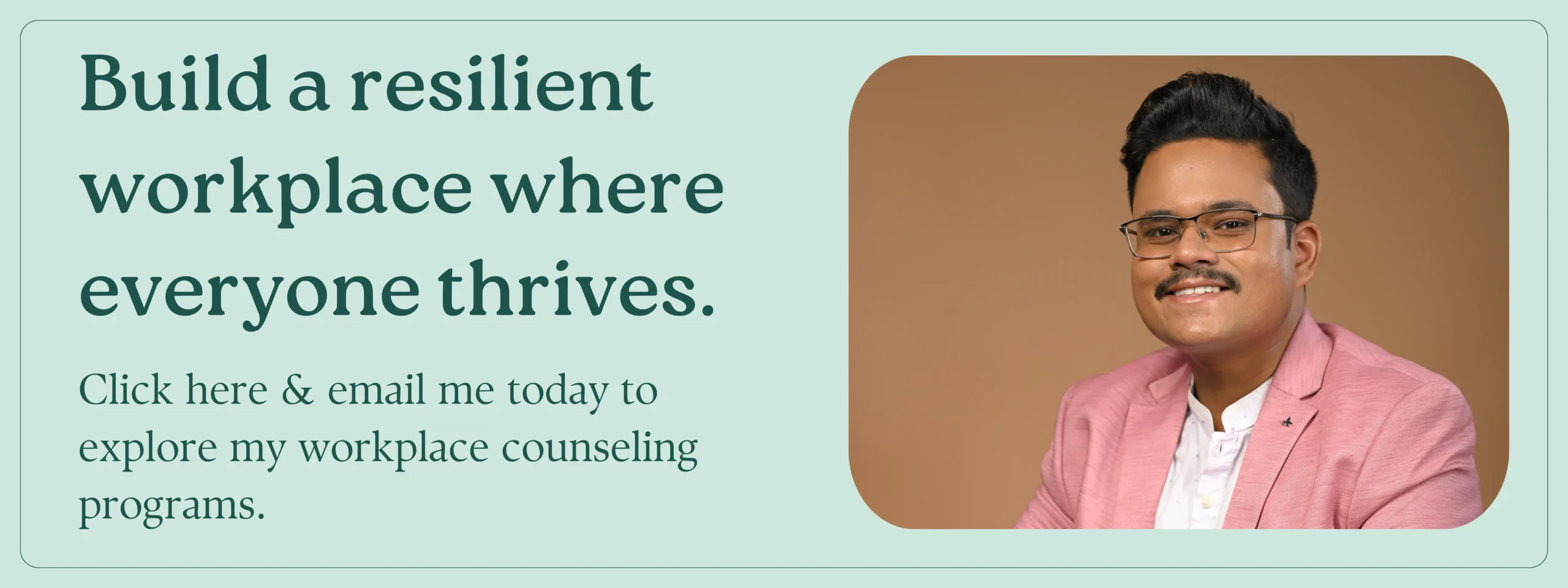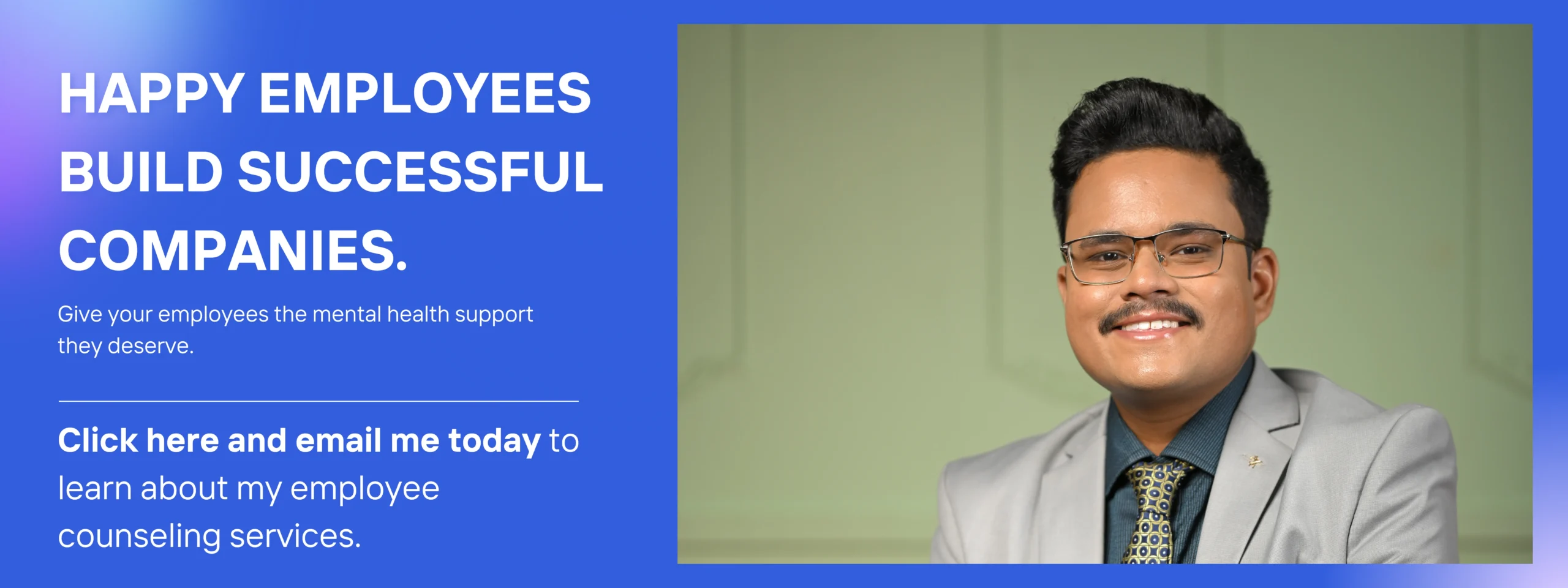“I don’t want my team to think I’m weak.” These words, spoken by a senior manager at a leading Indian tech company, capture the complex relationship many Indian professionals have with workplace mental health support. In my 6 years of providing employee counselling services across various corporate sectors, I’ve heard countless similar concerns. Yet, the landscape is changing, and organizations are increasingly recognizing that mental health support isn’t just about addressing problems—it’s about fostering a resilient, productive, and engaged workforce.
Table of Contents
ToggleUnderstanding Employee Counselling in the Indian Corporate Landscape
The corporate world in India presents unique challenges when it comes to mental health support. Our work culture, deeply influenced by collectivist values and hierarchical structures, creates distinct dynamics that require careful consideration in counselling approaches. Unlike Western corporate environments, where individual autonomy is often emphasized, Indian workplace relationships are typically more interconnected, with boundaries between professional and personal life often blurring.
The Evolution of Workplace Mental Health Support
The journey of mental health support in Indian corporations tells a fascinating story of transformation. Twenty years ago, the concept of corporate mental health initiatives was virtually nonexistent in India. Today, we’re witnessing a remarkable shift, driven by several factors:
- Global Integration: Indian companies operating internationally have been exposed to advanced employee wellness programs, leading to the adoption of similar practices domestically.
- Generational Change: Younger employees, particularly millennials and Gen Z, are more open about mental health and actively seek supportive work environments.
- Post-Pandemic Awareness: The COVID-19 pandemic dramatically highlighted the importance of mental health support, pushing organizations to implement more comprehensive employee counselling programs.
Modern workplace mental health support requires a multi-faceted approach that addresses both immediate and long-term needs. Organizations succeeding in this area implement three core support structures: preventive care, active intervention, and ongoing maintenance.
- Preventive care programs focus on stress management workshops, resilience training, and regular mental health check-ins. For example, one technology company I work with conducts monthly wellness sessions where employees learn practical stress management techniques they can apply immediately in their daily work.
- Active intervention involves providing immediate support during challenging periods. This includes crisis counseling services, peer support groups, and dedicated helplines. When implementing these services, organizations must ensure 24/7 availability, especially critical for companies with multiple shifts or international operations.
- Ongoing maintenance programs help sustain mental well-being through regular support mechanisms. These include quarterly mental health assessments, continuous access to counseling services, and regular feedback loops for program improvement.
Cultural Nuances in Corporate Mental Health
Understanding cultural context is crucial for effective employee counselling in India. Traditional values, family dynamics, and societal expectations significantly influence how employees perceive and engage with mental health support. For instance, in my practice, I often encounter situations where employees are hesitant to discuss work-related stress because it might reflect poorly on their family’s reputation or their ability to handle responsibilities.
Key Components of Effective Employee Counselling Programs
Building Trust and Ensuring Confidentiality
Trust forms the foundation of any successful employee counselling program. In India, where community ties are strong and privacy concerns significant, establishing robust confidentiality measures is crucial. This involves:
- Secure Documentation Systems: Implementing encrypted digital platforms for maintaining session notes and employee information.
- Private Consultation Spaces: Creating designated areas for counselling sessions that ensure complete privacy and discretion.
- Clear Communication Protocols: Establishing transparent guidelines about what information remains confidential and what (if any) needs to be shared with the organization.
Trust-building in employee counselling requires systematic implementation of privacy measures. Here’s how organizations can establish robust confidentiality:
- Physical Space Management: Create counseling spaces away from high-traffic areas. In one manufacturing company, we established a “wellness center” in a separate building, allowing employees to seek support without drawing attention.
- Documentation Security: Implement encrypted digital systems for record-keeping. All session notes should be stored in secure, password-protected databases with limited access rights. Consider using unique identifier codes instead of names for session documentation.
- Communication Protocols: Establish clear guidelines about information sharing. For instance, create standardized reporting templates that share only aggregated data with management, never individual details.
- Practical example: One IT company implements a “traffic light” system for reporting to management: Green indicates program utilization rates, Yellow shows general trends and patterns, and Red flags systemic issues requiring attention – all without revealing individual information.
Comprehensive Support Framework
Effective employee counselling programs require a multi-layered approach that addresses various needs:
- Individual Support: One-on-one counselling sessions focusing on personal challenges, work-related stress, and professional development. These sessions provide focused attention to specific concerns.
- Group Programs: Workshops and support groups addressing common challenges like stress management, work-life integration, and team dynamics.
- Crisis Intervention: Immediate support systems for urgent mental health concerns or workplace incidents.
A practical support framework must address various employee needs through multiple channels:
Individual Support Programs:
- Initial assessment protocols to identify specific needs
- Structured session formats (45-60 minutes) with clear objectives
- Progress tracking systems using standardized metrics
- Regular review and adjustment of support plans
Group Support Initiatives:
- Themed support groups (stress management, work-life balance)
- Peer support networks with trained facilitators
- Department-specific programs addressing unique challenges
Crisis Management Systems:
- 24/7 emergency support hotlines
- Rapid response protocols for critical incidents
- Clear escalation procedures for serious cases
- Post-crisis follow-up mechanisms
Integration with Organizational Culture
Success in employee counselling comes from seamless integration with existing organizational structures. This means:
- Policy Alignment: Ensuring counselling programs complement existing HR policies and workplace wellness initiatives.
- Leadership Engagement: Involving management in program development while maintaining appropriate boundaries.
- Cultural Sensitivity: Adapting counselling approaches to match organizational culture and employee demographics.
Successful integration requires aligning mental health support with existing organizational systems:
Policy Integration:
- Incorporate mental health support into existing HR policies
- Create clear guidelines for accessing services
- Develop support-seeking protocols that respect privacy
- Establish feedback mechanisms for continuous improvement
Practical Implementation Steps:
- Conduct department-specific needs assessments
- Create customized support programs for different employee levels
- Develop communication channels that respect hierarchical structures
- Establish measurement metrics aligned with organizational goals
Implementing Corporate Mental Health Initiatives
Creating Psychological Safety
The concept of psychological safety is relatively new in Indian corporate culture, yet it’s crucial for effective employee counselling programs. Here’s how organizations can foster it:
- Leadership Example: When leaders openly discuss mental health and support employee counselling initiatives, it significantly reduces stigma.
- Regular Communication: Consistent messaging about mental health resources and their benefits helps normalize seeking support.
- Clear Boundaries: Establishing explicit guidelines about confidentiality and professional boundaries helps employees feel secure in seeking help.
Building psychological safety requires concrete actions across organizational levels:
Leadership Practices:
- Regular check-ins with team members about wellbeing
- Open discussion about using support services
- Clear communication about confidentiality measures
- Modeling healthy work-life boundaries
Team-Level Implementation:
- Creating “no-judgment” zones for discussing challenges
- Establishing peer support networks
- Regular team discussions about mental health resources
- Clear protocols for addressing concerns
Training and Development
Successful implementation requires comprehensive training at all organizational levels:
- Manager Training: Equipping leaders with skills to recognize mental health concerns, have supportive conversations, and make appropriate referrals.
- HR Capacity Building: Developing HR teams’ capability to support and promote mental health initiatives effectively.
- Employee Awareness: Regular workshops and training sessions on mental health literacy and available support resources.
Effective training programs must be role-specific and practical:
Manager Training Components:
- Recognition of mental health warning signs
- Appropriate intervention techniques
- Proper referral procedures
- Documentation requirements and privacy protocols
HR Professional Development:
- Mental health first aid certification
- Crisis intervention training
- Program management skills
- Data analysis and reporting capabilities
Employee Education:
- Self-care techniques and stress management
- Available support resources and access procedures
- Peer support guidelines
- Work-life integration strategies
Measuring Impact and Success
Tracking program effectiveness while maintaining confidentiality requires careful consideration:
- Quantitative Metrics: Monitoring aggregated data on program utilization, employee engagement, and productivity indicators.
- Qualitative Feedback: Gathering anonymous feedback about program impact and areas for improvement.
- ROI Analysis: Evaluating program benefits against investment while considering both direct and indirect impacts.
Implement comprehensive measurement systems that protect privacy while demonstrating value:
Quantitative Metrics:
- Program utilization rates (monthly, quarterly, annual)
- Aggregate attendance patterns
- Department-level engagement statistics
- Return-to-work success rates
Qualitative Assessment:
- Anonymous feedback surveys
- Group discussion outcomes
- Trend analysis reports
- Success story documentation (with appropriate anonymization)
Common Challenges and Solutions
Addressing Stigma
Mental health stigma remains a significant barrier in Indian workplaces. Effective solutions include:
- Education Campaigns: Regular awareness programs addressing common misconceptions about mental health.
- Success Stories: Sharing anonymized examples of positive outcomes while maintaining confidentiality.
- Cultural Integration: Incorporating mental health discussions into regular workplace conversations and events.
Practical strategies for reducing mental health stigma:
Communication Campaigns:
- Regular mental health awareness messages
- Success stories from leadership (where comfortable sharing)
- Department-specific awareness programs
- Multi-channel communication approaches
Educational Initiatives:
- Monthly awareness workshops
- Expert-led sessions on common mental health challenges
- Family inclusion programs
- Cultural sensitivity training
Case Study: Transforming Workplace Mental Health
A leading Indian IT services company approached me with concerns about rising stress levels and declining employee satisfaction. We implemented a comprehensive employee counselling program that included:
- Initial Assessment: Conducting a thorough evaluation of organizational needs and existing support systems.
- Customized Implementation: Developing programs tailored to different employee segments and needs.
- Regular Evaluation: Implementing feedback mechanisms and adjustment protocols.
The results were significant: 30% reduction in stress-related leave, 40% improvement in employee engagement scores, and positive feedback from both employees and management.
The Future of Corporate Mental Health Support
Technology Integration
The future of employee counselling in India will likely see increased integration of technology:
- Digital Platforms: Secure online counselling options making support more accessible.
- AI-Assisted Tools: Supplementary digital resources for mental health monitoring and support.
- Data Analytics: Advanced metrics for program evaluation while maintaining privacy.
Practical technology solutions for modern employee counselling:
Digital Support Systems:
- Secure online booking platforms
- Virtual counseling options
- Mobile apps for mental health tracking
- Anonymous feedback mechanisms
Data Management:
- Encrypted storage systems
- Automated reporting tools
- Access control protocols
- Integration with existing HR systems
Evolving Workplace Needs
As work patterns continue to change, employee counselling must adapt to:
- Remote Work Challenges: Addressing mental health needs in hybrid and remote work environments.
- Work-Life Integration: Supporting employees in managing increasingly blurred boundaries between work and personal life.
- Cultural Shifts: Adapting to changing workplace dynamics and employee expectations.
Adapting support systems for contemporary workplace challenges:
Remote Work Support:
- Virtual counseling protocols
- Digital wellness resources
- Online group support sessions
- Remote crisis intervention procedures
Hybrid Workplace Solutions:
- Flexible support scheduling
- Multi-channel access options
- Integrated online and offline support
- Adaptive program delivery methods
Implementation Considerations:
- Regular needs assessments
- Feedback collection systems
- Program adaptation protocols
- Continuous improvement mechanisms
Conclusion
Effective employee counselling programs represent a crucial investment in organizational health and success. By understanding and addressing the unique challenges of the Indian corporate environment, organizations can create supportive, productive workplaces that benefit both employees and the bottom line.
Ready to enhance your organization’s mental health support system? Contact me to discuss creating a customized employee counselling program that addresses your specific needs while maintaining the highest standards of professional care.
Frequently Asked Questions
How does employee counselling benefit both the organization and employees?
Employee counselling creates a win-win situation by providing professional support for personal and work-related challenges while helping organizations maintain a healthy, productive workforce. Studies show reduced absenteeism, improved performance, and better employee retention in organizations with effective counselling programs.
What makes corporate mental health programs successful in India?
Success in India requires a careful balance of professional support with cultural sensitivity. Programs must respect traditional values while promoting progressive mental health practices, ensuring confidentiality, and addressing stigma through culturally appropriate approaches.
How can organizations measure the effectiveness of employee counselling programs?
We use a combination of quantitative metrics (attendance rates, productivity indicators) and qualitative feedback (anonymous surveys, aggregated session feedback) while maintaining strict confidentiality standards to demonstrate program impact.
What role do managers play in supporting employee counselling initiatives?
Managers serve as crucial bridges between employees and mental health resources. Through proper training, they learn to recognize signs of distress, have supportive conversations, and make appropriate referrals while maintaining professional boundaries.
How is confidentiality maintained in corporate mental health programs?
Strict confidentiality protocols protect all aspects of employee counselling. Session details remain private, with only aggregated, non-identifying data shared with organizations for program evaluation purposes.









1 thought on “Employee Counselling: A Comprehensive Guide for Indian Corporations”
It is in reality a great and helpful piece of information. I¦m satisfied that you just shared this useful info with us. Please stay us informed like this. Thank you for sharing.